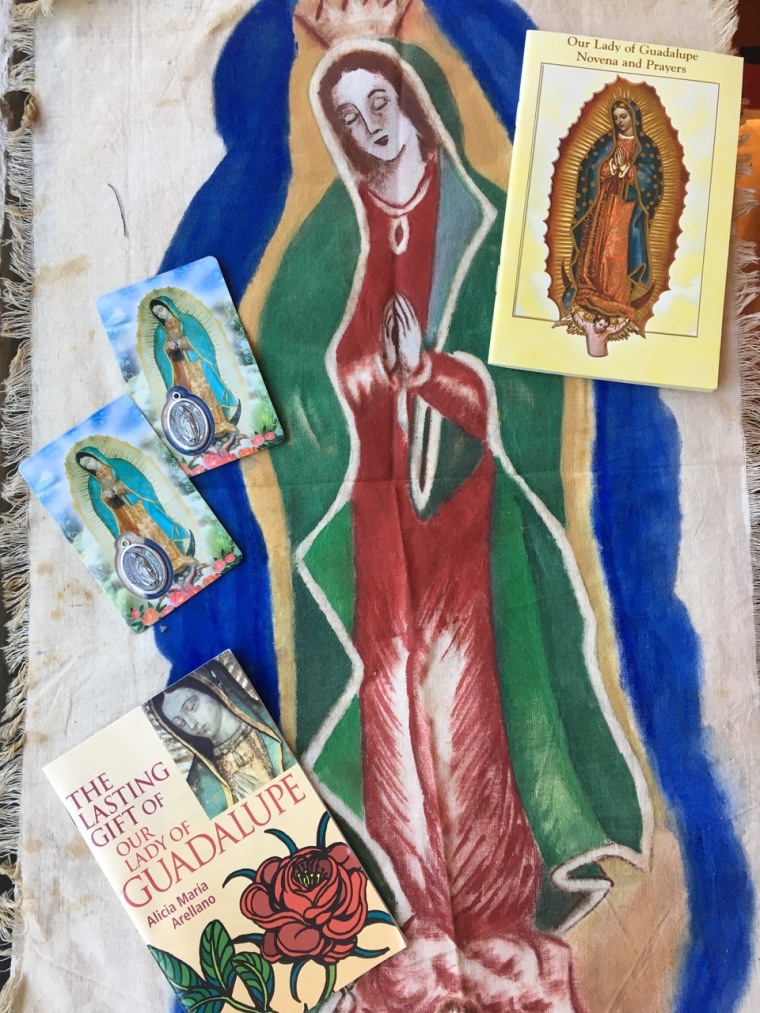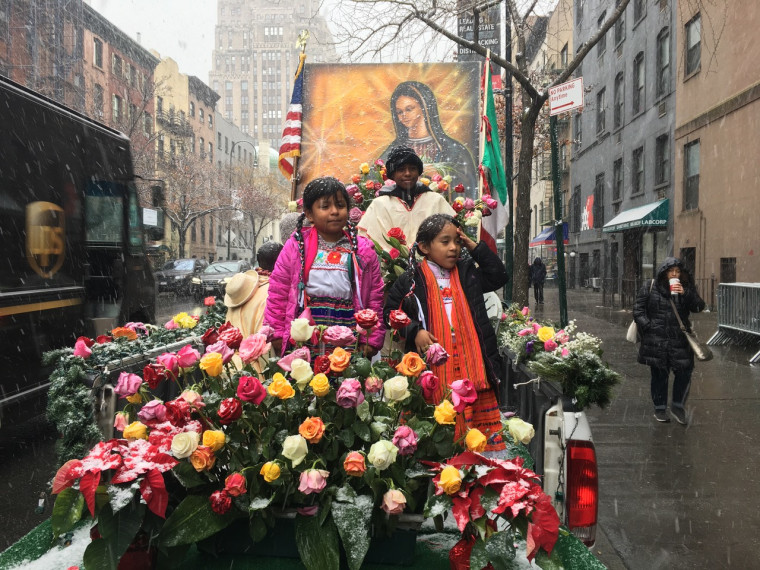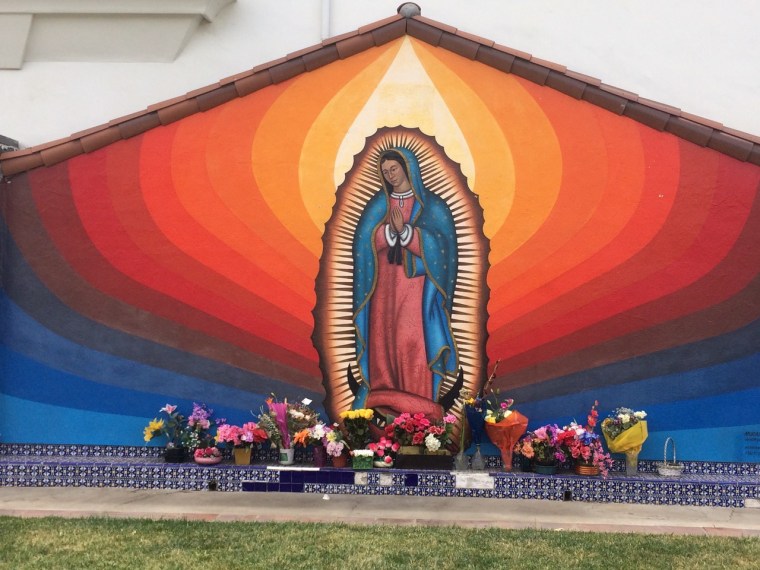If you see a colorful procession in your city or town on Tuesday, it may have to do with a venerated "lady" whose presence is ubiquitous in many Latino communities across the U.S.
The feast day of Our Lady of Guadalupe, also known as the Virgin of Guadalupe, is celebrated on December 12. For Mexicans and Mexican-Americans as well as other Latinos, Our Lady of Guadalupe is a powerful symbol of devotion, identity, and patriotism. Her image inspires artists, activists, feminists and the faithful.
Yet while Our Lady of Guadalupe is revered, recognized, and commercialized throughout Latin America, many Americans are likely unaware of the origins and impact of her iconic status.
But that may be changing.
Last Saturday morning in New York City, a group of volunteers from Our Lady of Guadalupe Catholic Church at St. Bernard’s were undeterred as snow drifted down and the temperature dropped to 33 degrees. They arranged flowers, flags, and banners, and lined up behind vehicles bearing large images of Mexico's patron saint, Our Lady of Guadalupe.
After a cry of “Listos?" (Ready?) the procession wound its way through Manhattan’s Chelsea neighborhood, the marchers reciting novenas, or prayers, singing songs, and drawing a mixture of curious and confused looks.
“I think it’s some kind of mariachi thing,” one onlooker murmured to his companion.
The procession was in fact a prelude to the Dec. 12th celebration, which will see Latino communities, from big cities like Los Angeles and Houston to smaller ones like Mason City, Iowa, honoring her legacy.
“In Christianity, for us, Our Lady signifies a lot,” said Father Juan Antonio Gutierrez of Our Lady of Guadalupe Church in El Paso, Texas. “She is the one who supports us, helps us, and protects us.” At his church, there will be special masses, a serenata (serenade), matachines (dancers), a procession, and the singing of the traditional song Las Mañanitas, in celebration of Our Lady of Guadalupe.
“She has been part of Mexican life for almost 500 years, and that’s why both believers and non-believers respect her image," said Gutierrez. "Our ancestors are represented through her; she represents us.”
Here are five things to know about Our Lady of Guadalupe – and why she matters to millions of Latinos today.
Our Lady of Guadalupe is an inextricable part of Mexican and Mexican American culture. Octavio Paz, the winner of the 1990 Nobel Prize for literature, once opined that “After two centuries of experiment and failure, the Mexican people only believe in the Virgin of Guadalupe and the national lottery.”
Even among Mexican and Mexican-American lapsed Catholics, it seems there is often a bond with Our Lady of Guadalupe as a cultural talisman. Her image is seen on murals and in museums, and on trucks and tattoos. Earlier this year, a contestant on “RuPaul’s Drag Race” brought a candle bearing the image of Our Lady of Guadalupe along with him into the competition for good luck – while in Mexico, an artist turned his cute renderings of Guadalupe into “Virgincita Plis,” a cartoon and merchandising craze akin to Hello Kitty. “Our Lady of Guadalupe has flowed over into the popular culture, in ways that once might have been considered disrespectful but today are not. She is on calendars, and used by gang members and prisoners who tattoo her image across their backs,” said writer Ana Castillo. “For many of us, growing up, God was an invisible, strict figure. He is remote, while Our Lady of Guadalupe is someone you can see, she is a palpable image – and she is the mother figure, forgiving and all-loving.”
Castillo, author of Black Dove: Mama, Mi’jo, and Me, said that feminists and activists for social justice still look to this centuries-old icon as a source of inspiration. “Many Chicana feminists see the Virgin of Guadalupe as having a connection with the pre-Columbian goddesses of Mexico. There is an acknowledgement of the long history of who she was before the Catholic Church imposed itself on Mexico. And throughout history goddesses have led or inspired movements; that’s why we see Our Lady of Guadalupe’s name and image invoked on behalf of immigrants, or against police brutality, or anytime people seek solace or protection.” While Our Lady of Guadalupe’s presence in popular culture has grown along with the growth of the U.S. Latino population, she retains the sense of being an accessible source of hope for poor, oppressed, or marginalized people.
Our Lady of Guadalupe is one of the most famous apparitions in the world. According to lore, in 1531 the mother of God appeared to a peasant named Juan Diego on a hill near present-day Mexico City and asked that he build her a shrine. Twice Juan Diego reported her appearance to his local bishop, who did not believe him. The second time, the bishop asked for proof. On the morning of December 12, the vision appeared again to Juan Diego and directed him to gather flowers at the top of the hill. This was unusual because it was winter and flowers were not in season. Nonetheless, he followed her instructions and discovered an array of Castilian roses. The "lady" helped Juan Diego arrange them in his tilma, or cloak, and he went back to his bishop. When Juan Diego showed the bishop his cloak, the roses tumbled out and on the inside of the cloak was an image of the Virgin Mary. Since then, this image has been known as Our Lady of Guadalupe.
What sets this purported appearance apart from others such as the visions in Lourdes or Fatima is that the “proof” that Our Lady of Guadalupe gave Juan Diego can still be seen today, on display at the Basilica of Our Lady of Guadalupe outside Mexico City. The tilma’s colors have not faded despite the passage of hundreds of years, and the cloak has reportedly defied some scientific explanation. The Basilica itself is one of the top tourist attractions in the country, drawing millions of visitors a year, including Pope Francis in 2016. The Basilica is a sacred place to devout Roman Catholics, as they believe it marks the only place in the Americas visited by the Virgin Mary.
The story of Our Lady of Guadalupe was a driving factor in the conversion of Mexico’s indigenous people to Catholicism. The apparition appeared to Juan Diego just ten years after Spain’s conquest of central Mexico. “The fact that Our Lady of Guadalupe appeared as a brown-skinned woman speaking Nahuatl to an indigenous peasant is an important part of the narrative,” said Laura G. Gutierrez of the University of Texas at Austin’s Department of Mexican American and Latina/o Studies. “The story was used by the Spaniards as a way to bring the native people to Catholicism. She appeared on a hill where indigenous people had previously worshiped the goddess Tonantzin, so in a sense people could feel that they were continuing this kind of veneration.” After the appearance of Our Lady of Guadalupe, millions of indigenous people converted to Catholicism.

The image of Our Lady of Guadalupe has played a role in historical events. When Father Miguel Hidalgo launched Mexico’s war of independence from Spain in 1810, his rallying cry was “Long live the Virgin of Guadalupe!” During the Mexican revolution, Emiliano Zapata and other fighters carried her image into battle. “In the 19th century, she became more of the symbol of the nation, and patriotism,” notes Gutierrez. “Our Lady of Guadalupe is present, in some form, during historical events and becomes a core part of Mexican identity.” Images of Our Lady of Guadalupe were used by Cesar Chavez during the Mexican-American civil rights movement, and by immigrants’ rights advocates in the 1990s and 2000s. This year, U.S. Bishops are encouraging people to celebrate the feast day of Our Lady of Guadalupe in solidarity with immigrants.
Depictions of Our Lady of Guadalupe have remained consistent for centuries – and she brings joy to the faithful on December 12. Our Lady of Guadalupe is usually shown looking downward in a pose of humility, with stars on her cloak and surrounded by golden rays. A sash around her waist indicates that she is expecting a child, which is a rare depiction of the Virgin Mary as pregnant.
“She endures so strongly in society because she represents motherhood and life-giving,” said Father Johann Roten, director of research, art, and special projects at the University of Dayton. “You don’t have to be Catholic to respond to the affirmation, affection, and security that she offers. These are central values that go all the way back to the first appearance of the apparition.”
Roten emphasizes that the image of Our Lady of Guadalupe represents the fusion of the Spanish and mestizo, or indigenous, cultures, which is, in a sense, a proxy for Mexico itself. “The story is also unique because it has concrete, relatable elements; the disbelieving bishop, the lowly peasant, and the evidence of the tilma (cloak) that was left behind.”

Perhaps writer Ana Castillo best sums up the ubiquity and importance of Our Lady of Guadalupe. “Anywhere you have more than one Mexican, whether in Toledo, Ohio or Toluca, Mexico, you will probably have a Virgin of Guadalupe sighting – because of the need and desire for her presence.”



